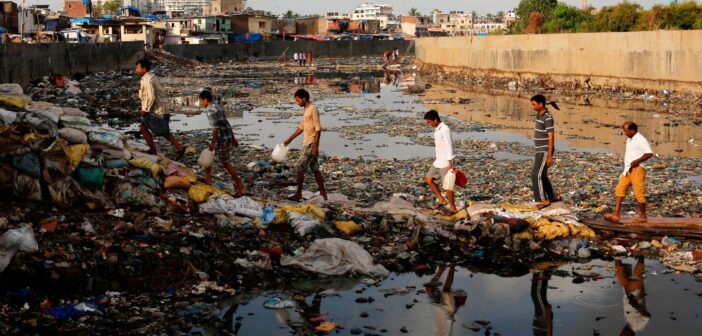The Sustainable Development Goals (SDGs) comprise of 17 goals with 169 targets to be achieved globally by signatory countries, including India, by 2030. Among these targets are several related to environmental protection. But what did BJP & Congress promise about major environmental issues in their manifestos since 2004.
The Sustainable Development Goals (SDGs) comprise of 17 goals with 169 targets to be achieved globally by signatory countries, including India, by 2030. Among these targets are several related to environmental protection. However, despite these stated goals, available data and other reports indicate that India like many other nations is grappling with serious issues related to environment, some of which need to be addressed immediately.
Against this backdrop, as a part of our series covering India’s 2024 general elections, this article explores the official data and other relevant reports surrounding critical environmental issues faced by India. Along with it, we also look at election manifestos of two major national parties, namely the ruling Bhartiya Janata Party (BJP) and the Indian National Congress (INC), for the years 2004, 2009, 2014, 2019 and 2024 to analyse what these parties have said on environmental protection in their respective manifestos.
Air, Water and Noise Pollution (SDGs 3, 6, 14 and 15)
Air, Water, and Noise pollution pose significant environmental challenges in India. According to a 2016 report by the World Health Organization (WHO), air pollution was responsible for 49 out of every 100,000 deaths in India in 2012. The periodic reports from the Central Pollution Control Board (CPCB) have also consistently highlighted elevated levels of air pollution in the country. Additionally, a recent parliamentary reply dated 05 February 2024 revealed that as of 2022, a total of 279 rivers in India exceed the prescribed pollution standards. Further, the issue of noise pollution is also well-known in India. Despite these issues, the analysis of the election manifestos of both the BJP and INC across the years shows a lack of substantive discussion on the same. (For further insights, refer to Factly’s coverage of Air, Water, and Noise Pollution stories).
| Manifesto Year | BJP | INC |
| 2004 | Control and regulation of pollution | None |
| 2009 | None | None |
| 2014 | Encourage cleaner production, Pollution control mechanisms will be setup on priority basis | Undertake cleaning of Rivers on a large scale |
| 2019 | With National Clean Air Plan (NCAP), reduce pollution levels in 102 cities by 35% in the next 5 years | All major sources of emission will be targeted, mitigated, and reduced to acceptable levels. Budget allocation for cleaning rivers will be doubled, and work with states to fully stop the discharge of effluents into rivers |
| 2024 | Will ensure achieving of designated air quality standards by 2029 | Will strengthen NCAP to tackle air pollution. Discharge of any kind of effluent into rivers will be prohibited by law |
Land Degradation and Coastal Erosion (SDGs 14 and 15)
Factly’s previous coverage on Land degradation revealed that, according to official data from the Indian Space Research Organization (ISRO), over 90 million hectares of land were classified as degraded as of 2015-16; land degradation refers to a loss of productivity, either temporarily or permanently. Another of Factly’s stories spotlighted findings from The National Centre for Coastal Research (NCCR), indicating that approximately 33% of coastal land experienced erosion between 1980 and 2018. However, neither of the two parties’ manifestos have consisted of any discussion or measures to be taken to address these issues:
| Manifesto Year | BJP | INC |
| 2004 | None | None |
| 2009 | None | None |
| 2014 | None | None |
| 2019 | None | None |
| 2024 | None | None |
Forest Cover (SDG 15)
The National Forest Policy enacted in 1988 aimed to encompass one-third of the nation’s total geographical area with forest or tree cover. Despite this policy being in place for over four decades, the objective remains unmet, with the current forest cover standing at only around 22%, as per a recent parliamentary reply dated 18 December 2023. The same reply also disclosed that India lost 168,131 hectares of forest in the last decade, indicating an average annual loss of over 15,000 hectares. While compensatory afforestation is mandated by law for forests lost to non-forest purposes, the process of regenerating a forest with its full ecological integrity takes years, if not decades. Compounding this challenge, a significant portion of existing forest land is in a degraded state. For instance, Factly’s previous story revealed that about 45% of India’s mangrove forests being in degraded state.
Additionally, the landmark Supreme Court order in the Godavarman case, directing each state government to identify and notify deemed forest lands based on the dictionary definition of a forest, remains largely unimplemented across most states. However, the manifestos of BJP and INC lack substantive details on how these issues will be tackled.
| Manifesto Year | BJP | INC |
| 2004 | Measures will be taken to promote afforestation | None |
| 2009 | Revisit laws for protection of forests. We will also launch engage citizens in promoting afforestation | Renewed emphasis on wasteland development and afforestation. |
| 2014 | Convert waste lands to social forestry and engage citizens in promoting afforestation | Strengthen the implementation of Forest Rights Act, which will serve as backbone for forest conservation |
| 2019 | We have ensured speed and effectiveness in issuing forest and environmental clearances for eligible projects due to which we have added around 9000 Sq. Kms to the forest cover of the country | Regeneration and afforestation of wasteland and degraded land. Work with States to improve forest cover and strengthen the laws and administration related to Forests |
| 2024 | We are committed to achieving the target of a carbon sink by enhancing the tree cover | Work with States to improve forest cover and strengthen the laws and administration related to Forests |
Climate Change, Himalayas Protection and Green Technologies (SDG 13)
Climate change is an acknowledged reality in India, supported by official data. For instance, a 2023 parliamentary standing committee report highlighted that India experienced a mean temperature increase of 0.7°C from 1901 to 2018, compared to the global average of 1.1°C. The report also underscored that the Himalayan region witnessed a temperature rise 0.5°C higher than the global average, exacerbating various adverse impacts. These include the disappearance of certain glacier lakes and water bodies, alongside others expanding in size due to glacier retreat (Explore pertinent stories of Factly here, here and here). Yet again, the manifestos do not contain substantive details of how these issues will be tackled and addressed.
| Manifesto Year | BJP | INC |
| 2004 | Green technologies development will be encouraged | None |
| 2009 | Encourage measures and give appropriate importance to contain climate change, develop programmes to arrest glaciers melting, develop alternatives to petrol and diesel, special emphasis on renewable energy | Unveiled national action plan on climate change, Power generation from renewables will be added |
| 2014 | Encourage measures and give appropriate importance to contain climate change, develop programmes such as national mission on Himalayas to arrest glaciers melting, Give thrust to renewable sources of energy | Continue to implement national action plan on climate change, Give a new thrust to Renewable energy, |
| 2019 | Himalayan states will be provided with special assistance to promote forestry, aim to achieve 175 GW of renewable energy capacity | Comprehensive framework including action agenda will be developed, independent authority for environmental protection will be constituted, Work with states to safeguard Himalayas. Encourage investment in renewable power |
| 2024 | Build resilient systems against climate change, strengthen disaster resilience in the Himalayan States, Harness renewable energy targeting 500 GW of renewable energy and set up appropriate systems | Formulation of National Climate Resilience Development Mission, Launch Green Deal New Investment Programme, constitution of independent environment and climate change authority, develop and implement national and state climate change plans. Promote green energy. Implement renewable energy schemes which make the panchayats or municipality self-sufficient in electricity as far as possible. |
Solid Waste (SDG 12)
India is also confronted with the issue of mounting solid waste with each passing year. Previous stories of Factly (accessible here and here) have showed that while solid waste generation is increasing steeply every year, the collection and recycling rates remain at inadequate levels.
| Manifesto Year | BJP | INC |
| 2004 | None | None |
| 2009 | Solid waste management will be enhanced for a clean and healthy city life | None |
| 2014 | Set up modern, scientific sewage and waste management systems | None |
| 2019 | Creation of sustainable solid waste management through Swachh Bharath | Implement solid waste management plan |
| 2024 | Eliminate open landfills with waste to wealth mission, launch series of programmes to address issues related to e-waste | We will bring law to make local bodies dispose solid waste |
Steep Challenges indicate that India is highly unlikely to achieve SDG targets relating to Environmental Protection by 2030
The Environmental Protection Act promulgated nearly 4 decades ago in 1986, defined “Environment” as including “water, air and land and the inter-relationship which exists among and between water, air and land, and human beings, other living creatures, plants, micro-organism and property.” However, official data and various facts concerning environment indicate the increasing gap between man and the environment.
Nearly 3 decades ago, the Supreme Court (SC) of India in the Vellore Citizens’ Welfare Forum case emphasized the imperative for regulatory authorities to anticipate, prevent, and combat the causes of environmental degradation. Yet, the plethora of environmental issues underscores the inadequacy and wide gap between measures taken and necessary to be taken for the conservation of the environment and achieving goals and targets outlined in both the SDGs and also in several national laws, including the Constitution of India.
To compound this, the recent parliamentary reply dated 7 August 2023 highlighted numerous impacts of climate change already experienced in India, such as a 75% increase in the frequency of daily precipitation, an increase in the number and spatial extent of droughts, a rise in sea levels, severe cyclones, etc. Additionally, a recent report from the Ministry of Earth Sciences forecasted a significant temperature surge of approximately 3 to 5°C across India over the next century due to climate change.
Despite the glaring situation at hand, it is ironic that even the latest manifestos of major national parties lack specific strategies for addressing these critical environmental issues with clear-cut road map on measures to address them.
India requires political parties to engage in dialogue and provide a clear road map to address social issues
Countries like the USA have a system where the contesting presidential candidates come to a common stage and publicly debate their positions & plans on specific issues. Unfortunately, such a kind of structured system does not exist in India though some television channels and civil society organize such events in a few places. We also do not see political leaders talk about specific solutions. Such a process will enable the voters to make an informed choice, as highlighted in the recent judgment of SC in Electoral Bonds case.



